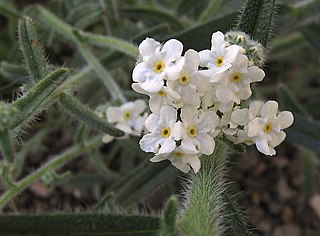
Cryptantha is a genus of flowering plants in the borage family, Boraginaceae. They are known commonly as cat's eyes and popcorn flowers. They are distributed throughout western North America and western South America, but they are absent from the regions in between.

Plagiobothrys is a genus of flowering plants known commonly as popcorn flowers. These are small herbaceous plants which bear tiny white or yellow flowers. Their fruits are nutlets. Although these plants are found predominantly in North America and South America, five species are known from Australia. Of the approximately 65 species described, more than 15 are endemic to California.

Eatonella is a North American genus of plants in the family Asteraceae containing the single known species Eatonella nivea, which is called by the common name white false tickhead. This small annual is native to the western United States, particularly the Great Basin, where it grows in sandy soils. It has been found in Washington, Oregon, Idaho, Nevada, and eastern California.

Johnstonella micromeres is a species of flowering plant in the family Boraginaceae known by the common name pygmyflower cryptantha.
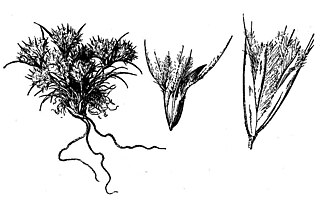
Blepharidachne kingii is a species of grass known by the common name King's eyelashgrass. It is native to the Great Basin in the United States, where it grows in habitat such as pinyon-juniper woodland. It is rare in California and Idaho, but it is one of the most common grasses of the northeastern deserts of Nevada.

Greeneocharis circumscissa is a species of flowering plant in the borage family, known by the common name cushion cryptantha. It is native to western North America from Washington to Baja California to Colorado and it is also found in Argentina. It grows in sandy or gravelly types of habitat, from mountains to desert, below 9,500 m (31,200 ft) above sea level.
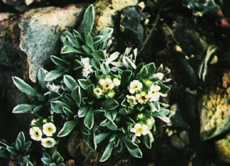
Oreocarya roosiorum is a species of flowering plant in the family Boraginaceae known by the common name bristlecone cryptantha.
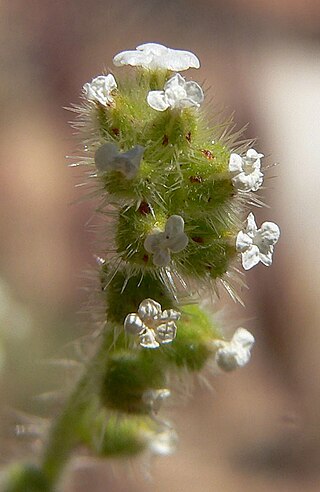
Plagiobothrys arizonicus is a species of flowering plant in the borage family known by the common name Arizona popcornflower.
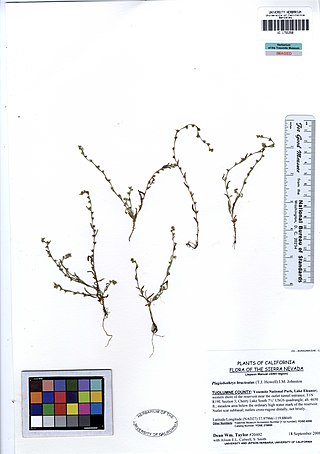
Plagiobothrys bracteatus is a species of flowering plant in the borage family known by the common name bracted popcornflower.

Plagiobothrys canescens is a species of flowering plant in the borage family known by the common name valley popcornflower. It is endemic to California, where it is a common wildflower in valley, foothill, desert, coastline, and canyon habitat in the central and southern regions of the state.

Plagiobothrys fulvus is a species of flowering plant in the borage family known by the common names field popcornflower or fulvous popcornflower. It is native to California and Oregon in the United States, as well as Chile.
Plagiobothrys greenei is a species of flowering plant in the borage family known by the common name Greene's popcornflower. It is native to Oregon and northern California, where it grows in moist woodland and grassland habitat. It is an annual herb with a spreading or erect stem growing 10 to 40 centimeters long. The leaves along the stem are 1 to 5 centimeters long and the herbage is coated in rough hairs. The inflorescence is a series of tiny flowers with white five-lobed corollas no more than 3 millimeters wide. The fruit is a minute nutlet with a surface covered in long prickles.
Plagiobothrys humistratus is a species of flowering plant in the borage family known by the common names dwarf popcornflower or low popcornflower. It is endemic to the Central Valley of California, where it grows in grassland habitats, including vernal pools and other wetland areas.
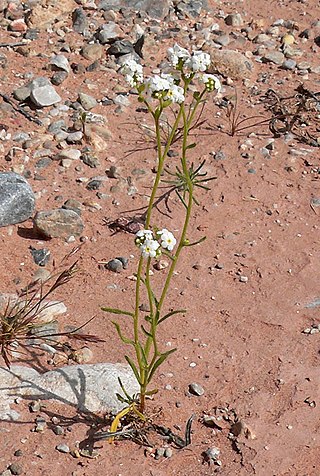
Plagiobothrys jonesii is a species of flowering plant in the borage family known by the common name Mojave popcornflower. It is native to the southwestern United States and northern Mexico, where it grows in desert mountains and flats in scrub and woodland habitat.
Plagiobothrys parishii, known by the common name Parish's popcornflower, is an uncommon species of flowering plant in the borage family.
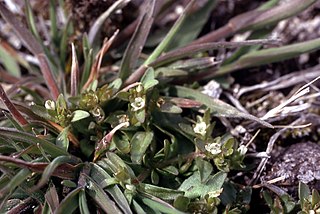
Plagiobothrys scouleri is a common species of flowering plant in the borage family known by the common name Scouler's popcornflower and white forget-me-not. It is native to North America, where it can be found from Alaska throughout southern Canada and the western and central United States. It is present in the United Kingdom as an occasional introduced species.
Plagiobothrys shastensis is an uncommon species of flowering plant in the borage family known by the common name Shasta popcornflower. It is native to southern Oregon and northern California, where it grows in grassland, woodland, and other types of habitat. It is an annual herb growing erect to about 30 centimeters in maximum height. It is coated in hairs. The leaves are located in a basal rosette with a few arranged alternately along the stem. The inflorescence is a straight branch holding paired flowers, rarely coiling at the tip as many other Plagiobothrys do. Each tiny white flower has a five-lobed corolla no more than 3 millimeters wide. The fruit is a cross-shaped nutlet 2 or 3 millimeters wide divided in half by a rough scar.

Symphoricarpos longiflorus is a species of flowering plant in the honeysuckle family known by the common names desert snowberry and fragrant snowberry. It is native to the western United States from the Great Basin to western Texas, as well as northwestern Mexico.

Pelecyphora minima is a rare species of cactus known by the common names Nellie cory cactus, Nellie's pincushion cactus, birdfoot cactus, and others. It is a very popular species among cactus collectors. This is one reason why it is a highly endangered species in the wild today. This cactus is found only in Brewster County, Texas, in the United States, where there are three populations remaining near Marathon. The cactus is limited to one outcrop in the Marathon Uplift, where it grows in rocky novaculite soils. It was added to the endangered species list in 1979.

Greeneocharis is a genus of flowering plants in the family Boraginaceae. There are about 63 species and its native range extends from western U.S. down to northwestern Mexico and to western Argentina. It is part of subtribe of Amsinckiinae.















